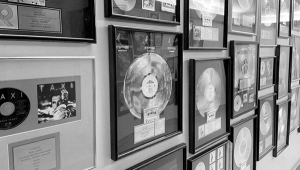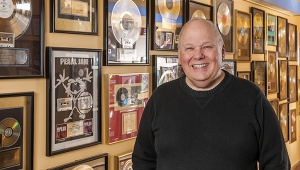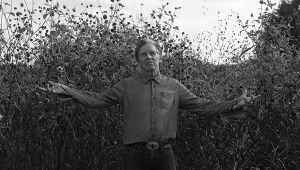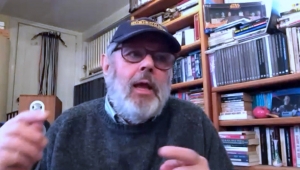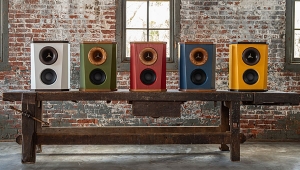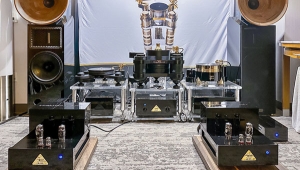| Columns Retired Columns & Blogs |
John Bau: Interstellar Overdrive Page 3
Boy, the light went on in my head. I immediately started investigating the Bessel algorithms, evolving models and playing around with time delay as an optimizable parameter—something I had never thought of before, and I don't know if anyone else had at that point. Not only can you play around with the slopes and enhance the phase response, but you can also move the mid section, or the bass/mid and the high section relative to each other in time, which creates its own phase relation between the two. By a process of elimination, I started working with the fourth-order Bessel because it was where the phase was linear at the crossover frequency, which at least I knew I needed. And after four or five days of work, with the help of the computer I came upon a combination of a fourth-order Bessel for the low-pass filter with something that was very close to first-order Butterworth on the high-pass. It was perfect up to about an octave and a half above the crossover point, with the error occurring at very high frequencies.
Now, if you look at that error on a phase graph, it looks pretty awful, but if you plot it as a time-delay curve, it looks very, very good because the time delay that it takes to create a phase aberration at high frequencies is very small. As a result, we were getting group delay characteristics that were flat within a few microseconds. All of a sudden, I knew what I needed to do, I'd got the key. This was also, by the way, a few days before the show. From the point of hitting on the key, the TC-50 came together in about five days.
We didn't get much sleep. After we'd optimized the baffle geometry and everything, and then optimized the crossovers, it was like four in the morning on the day that we had to leave for the show. We screwed 'em in and listened to them, and it was like, I think this sounds good. We threw them in the truck regardless and went off to the show, and the response was pretty astounding. Peter Moncrieff's IAR awarded us an engineering award—the gates had opened up and people were flocking in. The speakers sounded good, though I did hear some problems at the show. I had not given serious consideration to baffle reflection; complaints at that time about a paperiness in the sound coming from the cone was actually baffle-reflection problems from the tweeter—not from the cone. Small things like that.
Atkinson: What is your feeling on the relative importance of other loudspeaker aberrations—problems of resonances in the drive units, internal cavity problems, etc.?
Bau: They're definitely lesser. I had two main priorities: the crossover function, which is an integral part of the whole necessity for phase alignment; and the treatment of the immediate environment around the drivers because that's like the launching pad. If there was a sentence that really stuck with me when I was first learning about how loudspeaker units are designed, it was that they are basically designed for half-space use. The assumption is that they are going to be positioned on a huge infinite baffle with no surface discontinuities that they can see; half the energy gets thrown away and the other half comes into the room, but there is no break. Obviously there is no system that we can sell that will be like that, so on the TC-50 we could only do that to a limited extent, partly because of the timing of things, and partly because of a lack of insight and a lack of tools at the time. I started learning a whole bunch more about that once I got the Crown TEF analyzer.
Atkinson: The WCES in January 1988 was five years to the day since the appearance of the TC-50. What have you tried to do with the Angelus that you couldn't do with the TC-50?
Bau: Build the best $1000 speaker I could. Basically, spend a little bit more money, relax my preconceptions, and hope that the market would accept its cabinet shape; if the TC-50 had a design shortcoming, it was that I was not able to play around more with the area around the drivers. For its time, it was already an odd-looking box. And we weren't sure about acceptance of that. Fortunately, it sold on the merits of its sound.
With the Angelus, I wanted to use better drive-units, especially the bass/midrange unit. More overlap also became very important. The Angelus actually crosses over to the tweeter higher than the TC-50, which is interesting because it's a larger bass/mid unit. But the extension of that unit is better, being much more linear and much more predictable from unit to unit, so we could stretch the units there. The initial listening tests show that we didn't run into a great increase in modulation problems. In fact, we saw a decrease because of the better surface area. And a three-way system would not have performed as well overall, would not have had the coherence.
But one of the things I discovered in the interim is that there is in nature an optimum sequence of the arrival of events in time that ends up summing to give you the most linear amplitude response. It's what is called the "Fibonacci Series": the sum of the previous two numbers equals the next. The growth of plants and shells evidence it, and it turns out the one-third-octave and octave equalizers also conform to it. As soon as I read about it, it was like, OK, I need to check this out mathematically. So I would come to the lab and model this in the computer—you know, just creating little electronic equivalents of things coming out in time, and moving them around. It was right. This really works.
Since it's inevitable that we have diffraction and re-reflection problems, the whole quest is to make the area around the drivers present as few obstructions as possible, and to make sure that those obstructions that do exist are correlated in that sequence in time. For instance, if you measure a driver in its nearfield and then move back, you want those two measurements to coincide as much as possible; if you're going into correcting things with your crossover network, the instantaneous response vs the power response in the room is going to be quite a bit different unless that's the case.
Atkinson: So the strange shape of the Angelus baffle is to simulate an effective infinite-baffle environment for the tweeter. As far as the tweeter is concerned, by the time its output reaches a discontinuity, it has been reduced in amplitude by the felt so that any reflection is sufficiently suppressed.
- Log in or register to post comments

